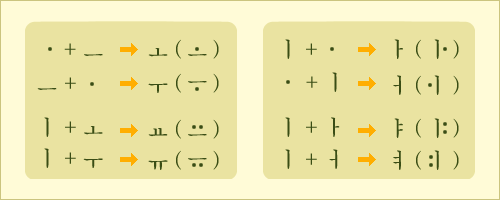| |
| |
 |
|
| |
|
|
| |





|
|
| |

Letters for vowels were created from the consideration
of not olny sounds but also philosophical principles.
Vowel letters are also divided into basic letters and
ones derived from them. People who created Han-geul
saw three vowels. 'ㆍ', ‘ㅡ’ and ‘ㅣ’ as basic. The letter
'ㆍ' symbolizes the round shape of the sky, the letter
‘ㅡ’ means the plate shape of the land, and the letter
‘ㅣ’ indicates the upright shape of the human. These
three, sky, land and human, are considered as the fundamental
features of all things in Oriental philosophy.
Other vowels were made by properly combining those three
letters. If 'ㆍ' is written over the ‘ㅡ’, ‘ㅗ’ is generated.
If 'ㆍ' is put under the ‘ㅡ’, it becomes ‘ㅜ’. If 'ㆍ'
is written on the right side of ‘ㅣ’, it becomes ‘ㅏ’,
while 'ㅓ' is made by putting 'ㆍ' on the left side of
'ㅣ'. Even though today's ‘ㅗ’, ‘ㅜ’, 'ㅏ', and 'ㅓ' look
as if horizontal and vertical lines are combined, at
the time |
 |
that Han-geul was created,
it clearly showed that each letter came from the combination
of 'ㆍ' and 'ㅡ', or 'ㆍ' and ‘ㅣ’. Each of ‘ㅛ’, ‘ㅠ’, ‘ㅑ’,
‘ㅕ’ has the same structure of each of ‘ㅗ’, ‘ㅜ’, ‘ㅏ’,
‘ㅓ’ except that 'ㆍ' is written twice. ‘ㅛ’, ‘ㅠ’, ‘ㅑ’,
‘ㅕ’ sound similar to ‘ㅗ’, ‘ㅜ’, ‘ㅏ’, ‘ㅓ' respectively,
except that they are diphthongs(double vowels) with
the glide(semi-vowel) 'ㅣ' attached in front. In this
regard, the relationship between simple vowels and double
vowels is reflected in the shapes of vowel letters. |
 |
 |
|
Today, the letter 'ㆍ' is not used
any more because the sound this letter used to represent
disappeared now. Other letters for double vowels were
made by combining letters for constituent simple vowels.
For example, ‘ㅗ’ and ‘ㅏ’ combine to make ‘ㅘ’ and under
the same rule, ‘ㅜ’ and ‘ㅓ’ combine to be ‘ㅝ’. Today,
'ㅐ' and 'ㅔ' are short vowels, but at the time when Han-geul
was first made, they were double vowels sounding /aj/
and /ej/.
Therefore, it was very reasonable to make 'ㅐ'
by combining 'ㅏ'and 'ㅣ' and 'ㅔ' by combining 'ㅓ' and
'ㅣ'. The same rule is applied to ‘ㅚ’, ‘ㅟ’, ‘ㅒ’, ‘ㅖ’,
‘ㅙ’, ‘ㅞ’. The sounds which these letters represented
were diphthongs(double vowles) or triphthongs(triple
vowels) just like the way their shapes suggest. But,
today they were simplified to simple or double vowels,
so that the relationship between letters and sounds
is not so clear any more.
Thanks to the systematicity of Han-geul, we can learn
Han-geul very easily. Our very low illiteracy, which
is internationally recognized, seems to be due to the
scientific feature of Han-geul.
The scientific feature of Han-geul also shows
its value even in this Digital Era. For example, think
about the input system of cellular phone used for sending
text messages. Because the number of keys is limited,
to each key are assigned more than one letter. In case
of Roman Alphabet, the letters that belong to the same
key have no common ground because shapes of letters
have nothing to do with their sounds.
In contrary, in case of Han-geul, if the shapes of letters
are similar, their sounds are also similar. Because
of this, it is easy to assign several similar sounds/letters
to one key. And so it is also easy to know which letters
are on which key, so that users can input text message
fast using cellular phones. |
 |
|
|
|
|
|

